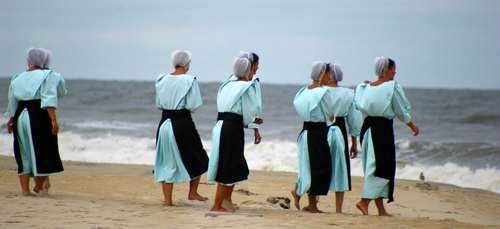
Your complimentary articles
You’ve read one of your four complimentary articles for this month.
You can read four articles free per month. To have complete access to the thousands of philosophy articles on this site, please
Prejudice & Perception
An Education In Diversity?
Christina Easton asks if a liberal education can be forced on non-liberal communities.
The great liberal philosopher John Stuart Mill (1806-1873) declared it “almost a self-evident axiom” that all children must be educated. Modern liberals tend to agree that education should be compulsory for minors in some form. However, here the agreement stops and some seemingly intractable problems arise. Education is seen as a means to liberty in later life; but what, for instance, should we say or do when imposing education conflicts with someone’s present liberties? And how can the liberal be consistent in valuing a diversity of views while advocating compulsory education, since the moment we state which education must be compulsory, we bring in a controversial vision of ‘the good education’, which may not be agreed upon by all who are forced into it?
These issues came to a head in the famous court case of Wisconsin v. Yoder (1972). A number of Amish parents, represented by Yoder, objected to the Wisconsin state law that requires school attendance until age sixteen. The Amish did not object to schooling up until fourteen, as this could take place in local Amish schools. But the further two years entailed attending non-Amish High School, exposing the children to an ethos in conflict with Amish values. Instead of High School, Amish teenagers continued their education informally within the community in agricultural work for men and domestic work for women. The court ruled in favour of Yoder, arguing that the Wisconsin law violated the parents’ right to freedom of religion by preventing them bringing up their children in the separation and simplicity essential to Amish life.

Amish at the beach
© Pasteur 2007
Liberal Differences Of Opinion
Many liberals think that the court judgment should have gone the other way. In their view it is justifiable for the state to impose a law requiring that Amish children be exposed to diverse values and ways of living. In On Liberty (1859), Mill extols the value of diversity in contributing to society’s long-term happiness: just as different environmental conditions are required for the optimal growth of different plants, so will a variety of ‘experiments of living’ enable different people to be the best that they can be. Modern liberals use a similar idea to argue that it would be wrong to assume that Amish children are all the same, and so they need to encounter a variety of options and decide what best suits their character. A similar opinion was voiced by Justice Douglas, delivering the dissenting opinion in court. He appealed to “the right of students to be masters of their own destiny,” and argued that to keep an Amish child from experiencing High School means “the child will be forever barred from entry into the new and amazing world of diversity that we have today.” More recently, the legal philosopher Joel Feinberg has also argued in favour of the Wisconsin law on the basis that the liberal state should be neutral, meaning that it “would act to let all influences, or the largest and most random possible assortment of influences, work equally on the child, to open up all possibilities to him” (Freedom and Fulfillment, 1992, p.85).
The trouble with these views is that whilst they are liberal in the sense of being open to a variety of views of the good life, in another sense they are deeply illiberal. Although they recognize that there is disagreement in society about which view of the good life to accept, they ignore the fact that there is also disagreement on the more fundamental question of whether we should be valuing autonomy and diversity. So Feinberg justifies a diverse education by appealing to people maximising their chances for self-fulfilment, but he assumes that this requires the exercise of autonomy to pursue diversity. Yet from an Amish perspective, exposure to diversity could lead to moral compromise and even rule out eternal fulfilment in the afterlife, and so would thereby not maximise self-fulfilment. Feinberg’s view is therefore far less neutral than he believes. Indeed, Mill’s vision of nurturing “open, fearless characters” is no doubt anathema to Amish parents, who generally value submission and meekness. So whilst it may be clear to some liberals that exposure to diversity will benefit Amish children by enriching their available options, this justification will have little appeal to the Amish themselves. It may even appear to them that forced exposure to diversity amounts to indoctrination into liberal values.
Public Agreement
The political philosopher John Rawls (1921-2002) argued that if liberals are really concerned with respecting people in the face of disagreement, then any coercive education policy should be justified with public reasons – reasons which are acceptable to the public as a whole, and which therefore do not refer to controversial views of the good life. He criticised Mill for resting his liberalism “in a large part on ideals and values that are not generally…shared” (‘The Idea of an Overlapping Consensus’, Oxford Journal of Legal Studies, 1987, p.6). So can liberals, in the spirit of Rawls, justify exposing children to diversity against the will of their parents in a way that appeals only to public reasons?

Amish shopping trip
© Juha Jousi 2012
Firstly, they might say that if citizens are to get along in spite of their disagreements, there needs to be exposure to diversity. In order to see disagreement as reasonable – or at least, to see that those with whom you disagree are not entirely irrational – you need to engage with those with whom you disagree. Such encounters also provide opportunities for the cultivation of mutual respect and solidarity. This appeal to peaceful co-existence could be seen as a ‘public reason’, for peaceful co-existence seems to be something that every reasonable person would want, regardless of their specific views of the good life.
Secondly, Rawls argued that education should develop one’s ability to “participate in [society’s] institutions”. Being an active citizen in the democratic process requires at least some basic skills of rational deliberation; and one important way that these skills are gained is by engaging thoughtfully with different points of view and people with different values and backgrounds.
Given public reasons such as these, perhaps Rawls would argue that the state should override the wishes of Amish parents for their childrens’ educational isolation. That his view could have such implications is indicated when he writes that “The unavoidable consequences of reasonable requirements for children’s education may have to be accepted, often with regret” (Political Liberalism, 2005, p.200).
Rawls versus Mill
Liberals today often prefer this Rawlsian-type justification, since by appealing to what all reasonable citizens value it is ‘more neutral’ than justifications appealing to autonomy and diversity, and is therefore better able to cope with the disagreement that is a feature of modern democracies.
“Hold on!” says the defender of Mill: “When Rawls says that his liberalism ‘requires far less’ for education than Mill’s liberalism, this implies that Mill has a more demanding view of education. Yet this simply doesn’t fit with what Mill said.” In fact, Mill didn’t have a precise view of what type of education was necessary. Rather, he wanted the state to “leave to parents to obtain the education where and how they pleased” (On Liberty, 1859, Ch. V, para 13). He wanted diversity of education, not the education in diversity suggested by the above justifications. Indeed, he argued that “A general State education is a mere contrivance for moulding people to be exactly like another” (ibid).

Amish school run
© Gadjoboy
One might respond by saying that this isn’t what Mill should have said if he is to be consistent. Indeed, some of Mill’s own comments lead us to think that his minimum education requirements would not be fulfilled by the Amish education in agricultural, carpentry and home-making skills, since he says that children should be taught the knowledge required to draw conclusions on matters of controversy, and even suggests that such knowledge be monitored by public examinations. Elsewhere, Mill talks about the need for a meaningful right of exit from Mormon communities – which might lead us to think that he would want Amish children to have an similarily informed awareness of alternatives. This might perhaps be fulfilled by the Rumspringa, a practice in many Amish communities whereby older teenagers are allowed to leave temporarily to experience alternative ways of life before making a decision about their future.
Whatever the verdict on Mill, we can still press the point against Rawls by arguing that the public reason defence for imposing liberal education can hardly be called ‘neutral’. For the public reason defence to work, exposure to diversity must be generally viewed as more important than values that necessitate a life of separation. Yet this is precisely what the Amish want to resist. They may accept the public reasons, but believe these to be outweighed by their religious reasons. So justifying the Wisconsin state law by appeal to public reasons might be neutral in avoiding relying on controversial views, but it fails to be fully neutral, since it requires rejecting some important Amish beliefs.
Changing The Culture
Whatever view we take, reflecting on this case helps us realise that liberals need to be more cautious in making claims to neutrality, and more honest about where they fail in this aspiration. We must also make sure that our arguments attend to the reality of the situation. Both the Millian and Rawlsian arguments invoked the importance of diversity, yet the modern High School is not simply a melting pot of different ways of life and an impartial reflector of all values. Rather – as Chief Justice Burgerpointed out – High Schools tend “to emphasize intellectual and scientific accomplishments, self-distinction, competitiveness, worldly success, and social life.” Moreover, peer pressure, and, particularly amongst teenagers, the need to conform, are likely to promote homogenisation of views. So if liberals are to be able to consistently defend compulsory attendance in state-provided education, school culture would itself first have to undergo some dramatic changes. Schools would need to both exhibit and actively promote a diverse range of ways of life, as well as provide opportunities for majority values, such as individual self-achievement, to be questioned. The challenge for head teachers and policy-makers is to implement strategies that protect minorities from extraordinary pressure to conform without them having to resort to separation.
© Christina Easton 2017
Christina Easton is a doctoral researcher in Philosophy at the London School of Economics. Visit personal.lse.ac.uk/davisce2/ or follow her @ChrEaston.









